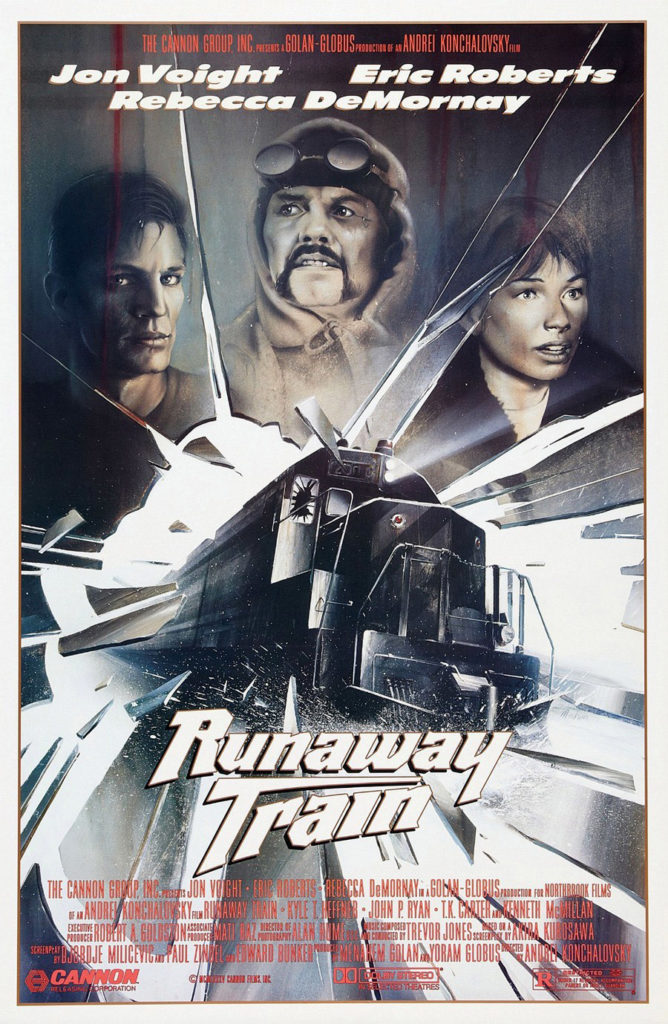1985’s Runaway Train is a very unique film. It’s American made, filmed in the white wastes of Alaska, but in a blind taste test, cinephiles would swear it was a Russian film. The film stock, the cinematography, set designs, costumes, etc., all scream that the film was made on the other side of the Iron Curtain. That’s not by design, but a result of the film being helmed by Andrei Konchalovsky, who, until the 1980s, was a Soviet filmmaker.
Runaway Train follows the trials and tribulations of Oscar Manheim (Jon Voight) and Buck McGeehy (Eric Roberts), a pair of convicts housed in an isolated maximum security prison in Alaska. ‘Manny,’ as Manheim is called, has just been let out of his cell by court order after three years welded inside on order of the sadistic Warden Ranken (veteran character actor John P. Ryan). Now that Manny is back in gen pop, he wastes little time escaping through a sewer pipe, bringing Eric Roberts along.
Into the wild they go, doing their best not to freeze to death, until they happen upon a rail yard where they stow themselves away aboard a multiple unit of locomotives that are getting set to leave the yard. Up in the front locomotive, the engineer has a heart attack and dies, in his death throes conveniently breaking all the stuff in the cab that stops a wayward locomotive, and the train is now a runaway. The remainder of the film is split between the train and the frantic control tower that is trying to figure out how to stop it. Voight and Roberts are joined on the train by Rebecca De Mornay, as a young railway worker  who was catching a nap in one of the locomotives when the train broke loose. De Mornay might as well have been included as ballast. Her character provides some technical insight, but her presence is a lazy effort at including a pretty face.
who was catching a nap in one of the locomotives when the train broke loose. De Mornay might as well have been included as ballast. Her character provides some technical insight, but her presence is a lazy effort at including a pretty face.
That’s not her fault, though. She got to be in a movie. Good for her. As for Voight and Roberts, the two of them playing off of each other is a case study in overacting. The two of them cooked up a pair of legendary baked ham dinners in Runaway Train. Everything I hated about Eric Roberts in The Pope of Greenwich Village is on display here. It’s as if his entire training in acting consisted of miming the mannerisms of 1930s gangster film sidekicks. Wild gesticulations, nervous rambling, shameless ass-kissing...I know what he was doing. He was channeling Chester, the sidekick to Spike the bulldog in the Warner Brothers cartoons. Those cartoons were spoofs. Roberts was being serious. Good lord, he was nominated for an Oscar for this role.
I’m not sure Voight had any other choice but to play up his role. He can act. We’ve all seen it (Deliverance). But he can also take it too far. We’ve all seen that, too (Anaconda). Anaconda Voight showed up in this one. But while Roberts was cartoonish and interminable, Voight was only a little cartoonish and just merely annoying. As if these two would-be Oliviers weren’t enough, Ryan and the crew from the control tower felt the need to go over the top with their performances, as well. Hmm, I’m beginning to think maybe Mr. Konchalovsky deserves some of the blame.
So, despite all the pork in the air, is the movie any good? Surprisingly, it’s not bad. The look of the film is great, and the pedigree of the story is not to be dismissed. Sure, the story is more than just a little improbable, but it came from a screenplay originally written by Akira Kurosawa. He wasn’t able to pull off the project after his financing fell apart, but it’s still a pretty strong story in others’ hands. Knowing the film’s origins, and being familiar with Japanese cinema, adds another layer of depth to the film below the obvious Soviet influences.
The characterizations are very typical of Japanese cinema. The regretful, almost mournful veteran criminal in Voight. The young hothead who strives to please his master in Roberts. De Mornay, the damsel in distress who adds little to nothing to the plot, other than giving the young hothead a case of the flushes. The youngish train controller in the tower (Kyle T. Heffner), who takes much of the blame for the runaway because he decided to buck tradition and install a modern train tracking system (trust me, you see enough Kurosawa films, guys like this are a staple). And finally, the rank, easygoing degree of misogyny, atypical for American films of the era, but an afterthought in Japanese cinema.
What we have, then, is a Japanese film, directed and styled by a Soviet, and starring Americans. It’s a fascinating piece of cinematic history. If a viewer can stand Eric Roberts, it’s worth a look. A one-time look.
